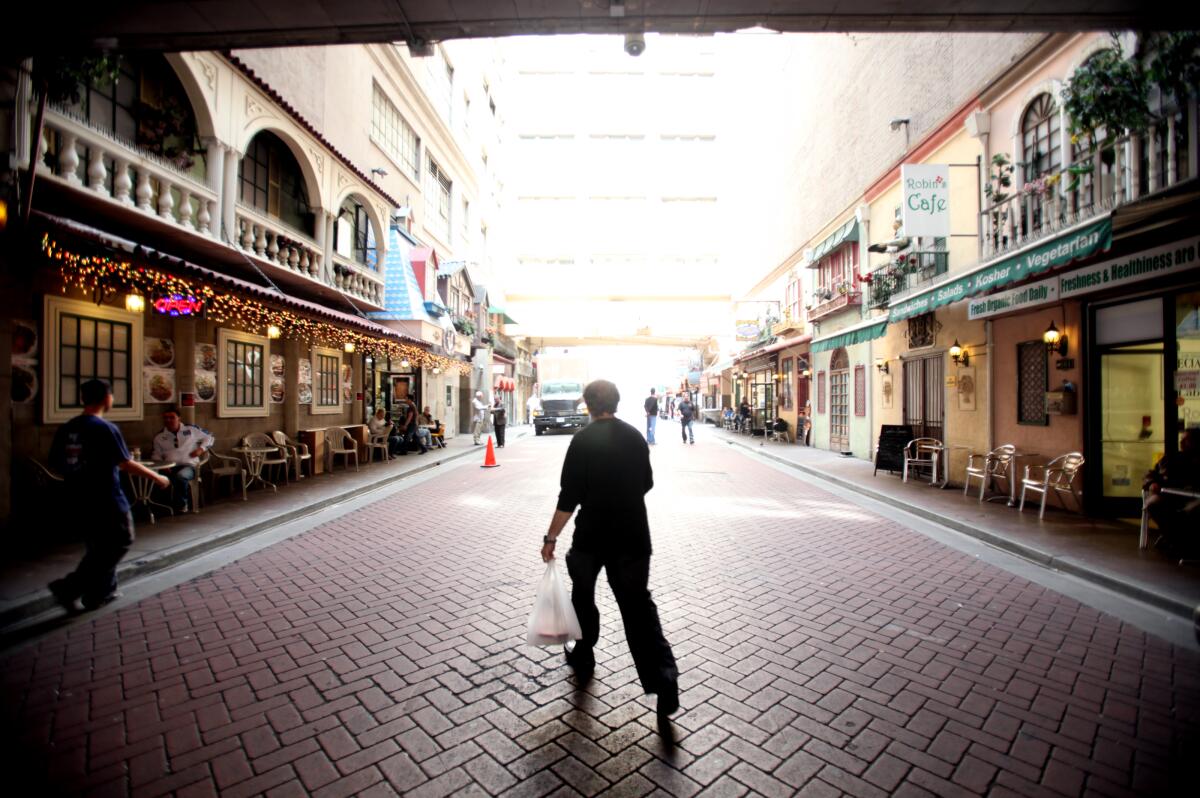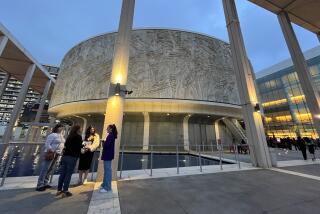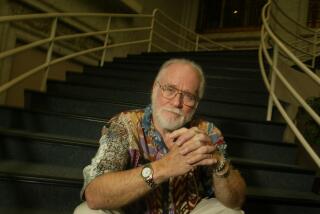Quaint downtown L.A. alley cleared of outdoor dining

Around the corner from the bustle and roar of Broadway’s Jewelry District in downtown L.A., a quiet alley serves as a respite for locals and tourists.
Shops and restaurants with colorful awnings and peeling brick facades present a kitschy, Old World scene, complete with a potbellied chef statue, and a Marilyn Monroe perched in a pink Cadillac. On most days, a group of Armenian men can be spotted hunched over a backgammon board, shrouded in cigarette smoke.
But the fate of St. Vincent’s Court — a California historical landmark — has been thrown into question after a complaint prompted a city crackdown on outdoor seating.
“Now, it’s a ghost town,” said Anto Nerses, co-owner of Sevan Garden, a Middle Eastern restaurant in the alley. “All the tourists are gone.”
For years, city officials looked the other way as merchants in St. Vincent’s Court placed their tables in the street — a violation of the public right of way and a persistent hindrance to trucks trying to reach the Los Angeles Theatre’s loading docks at the end of the alley.
Theater owner Shahram Delijani said he complained to the city because restaurant owners were blocking his trucks and demanding payment from movie production companies who parked at the end of the alley.
The extra headache sent their business elsewhere, Delijani said.
Delijani’s theater, which his father bought in 1982, is critical to Councilman Jose Huizar’s initiative to revive Broadway as an entertainment destination. With the help of a planned streetcar system, Delijani wants to stage 200 to 300 live events and lure an estimated 200,000 visitors to the area each year.
His father, Ezat Delijani, bought four Broadway theaters and always dreamed of seeing the seats filled again. Now, Shahram Delijani is trying to honor his father’s legacy.
Delijani said the family has already spent $5 million fixing up the Los Angeles Theatre and $15 million more is budgeted, but the path to progress runs through St. Vincent’s Court.
“I don’t know what happened. It was not supposed to come to this point,” said Tulip Cafe owner Kacin Celik, from his largely empty dining room. “People ask me why open a restaurant in an alley. I say it’s old, it reminds me of my country, it make me feel at home.”
He stops abruptly and stands, incensed. A homeless man is relieving himself against the wall outside. Celik barrels over and yells at him until he zips up and leaves.
“That never used to happen,” he said.
The alley, also known as St. Vincent’s Place, was largely created by happenstance, said Linda Dishman, executive director of the Los Angeles Conservancy.
Now a California historical landmark, the alley began life as the entrance to St. Vincent’s College, the city’s first Catholic university. In 1907, the university was replaced by a Bullock’s department store.
Shoppers flocked to Bullock’s, a seven-story block of gleaming displays bathed in the soft yellow glow of early electric lights. Bullock’s soon annexed the building next door, adding a connecting bridge over the alley.
But the alley was an eyesore and in 1956, Bullock’s and the city’s beautification committee planted flowers and erected colorful awnings and ornamental lamps. Later, renovators painted murals and added a cafe and flower shop.
The accumulated changes gave the alley a contrived but quaint look that even charmed locals.
In 1974, Times columnist Jack Smith wrote about the alley’s “amiable pretensions” and compared it to a street in Paris. In 1980, Times writer John Pashdag, writing about Pasquini Espresso Bar, called it a “place for New Yorkers who miss the grim, noise and canyon-like feel of downtown Manhattan.” More than 20 years later, in 2003, Huell Howser pronounced the alley the perfect definition of a neighborhood.
Downtown resident Matan Abel visits three times a week for coffee and a cigarette. He said he appreciates the alley’s intimate feel.
“I’d rather hang out here than those new parks,” Abel said. “There are locals and family run businesses.”
But the loss of outdoor seating is taking its toll. Some restaurants have laid off workers.
Norayir Oz, co-owner of the oldest business in the alley, said his restaurant can only seat two people inside. As a result, daily sales at St. Vincent’s Deli have plummeted.
“Now, after 27 years, someone makes a complaint, and I lose this business,” Oz said.
He doesn’t understand why the community celebrates new parklets jutting into Spring Street as triumphs of urban design, but in St. Vincent’s Court, outdoor seating is a nuisance. (His application for permitted seating was rejected.)
“It doesn’t make sense,” said Oz, who has cut his employees’ hours and now washes dishes himself.
The priorities have changed since Oz opened his restaurant. Years of development efforts are starting to show results. Today, fancy restaurants and hip pizza joints scrum with jewelry stores and jeans shops on Broadway, a street that many consider on the front line of downtown’s revitalization.
Big plans for Broadway depend on drawing crowds to the street’s 12 historic theaters, which Huizar has called “anchors” to revitalization.
“When 200,000 people annually come to the theaters, all of the businesses in the area will benefit massively,” Delijani said.
Delijani said he tried to negotiate a compromise before complaining to the city.
The original plan for the alley was to expand the sidewalks and make the seating legal in exchange for exclusive parking rights for about 10 hours a day near the theater’s dock, Delijani said.
But Peklar Pelavjian, the neighboring property owner, refused to give Delijani exclusive parking rights, saying it would hamper his own plans for retail development.
Huizar said he thinks both the alley and the theater are valuable assets and is willing to mediate the dispute if asked. He expressed support for a plan that includes widening the sidewalks to accommodate permitted outdoor seating, so long as the theater has some dedicated loading spaces.
“We get a big bang economically and socially if each side gives a little,” Huizar said. “There is a compromise to be found there.”
More to Read
Start your day right
Sign up for Essential California for news, features and recommendations from the L.A. Times and beyond in your inbox six days a week.
You may occasionally receive promotional content from the Los Angeles Times.







